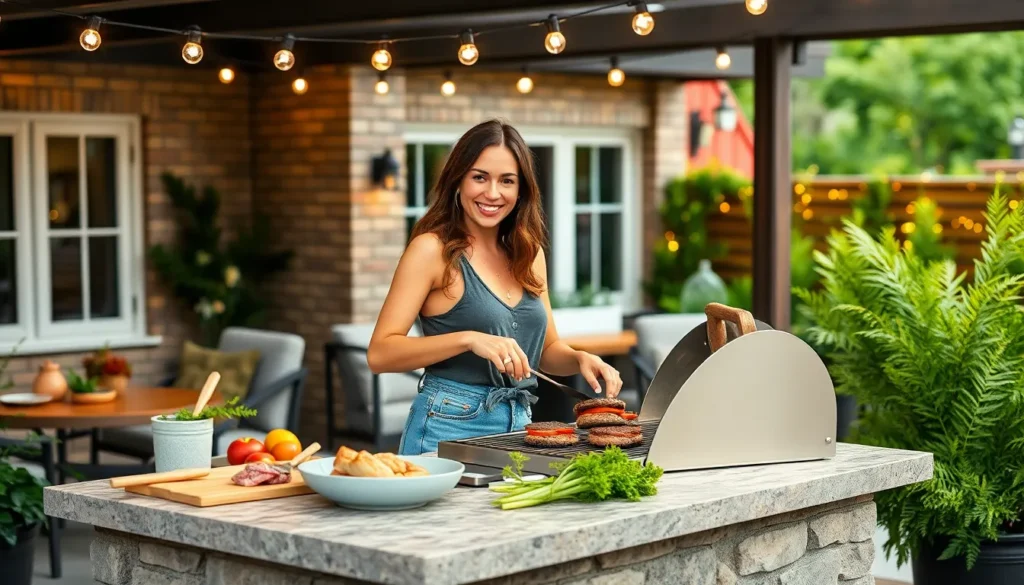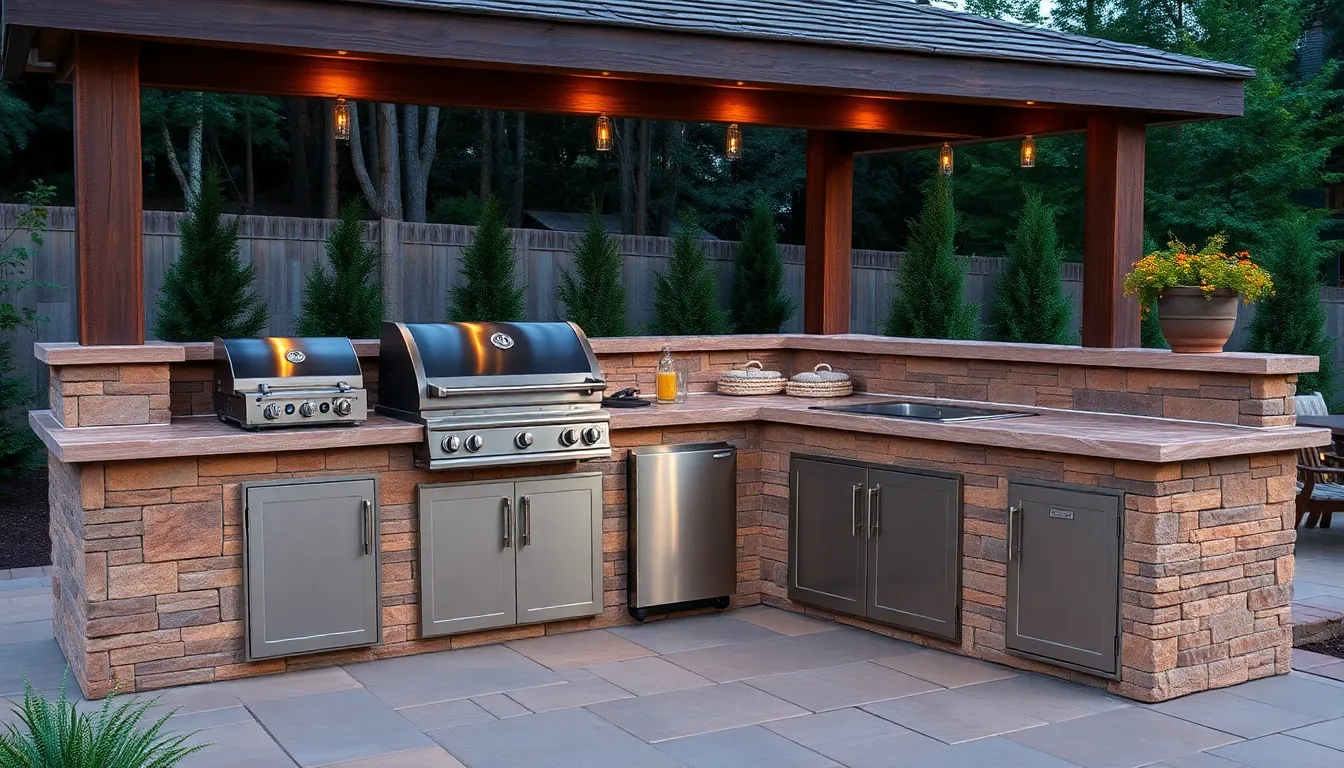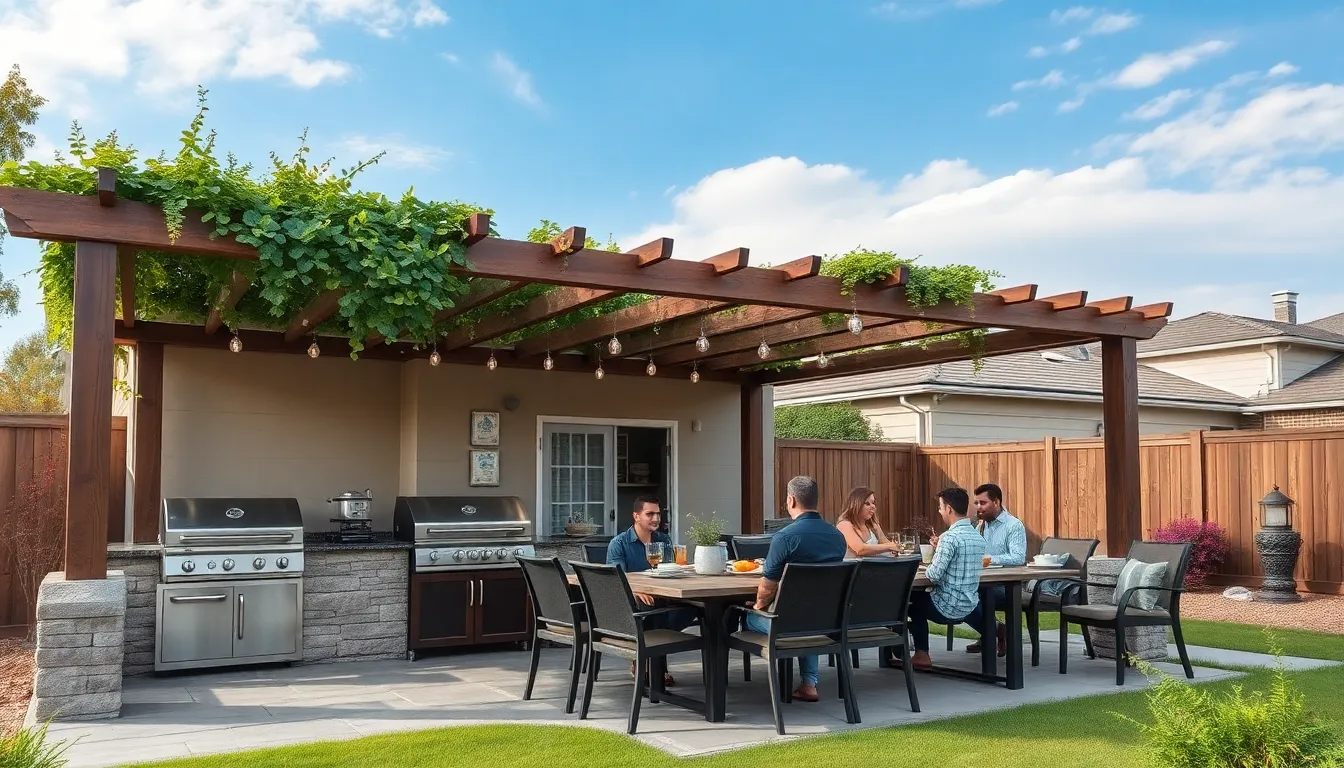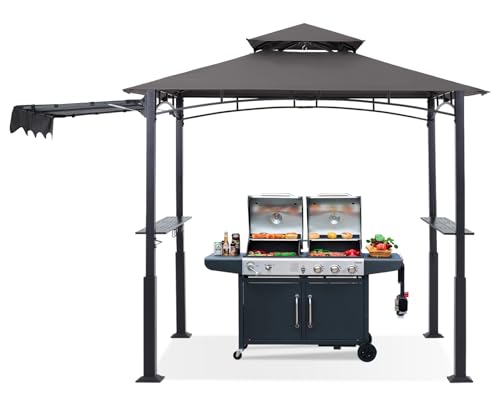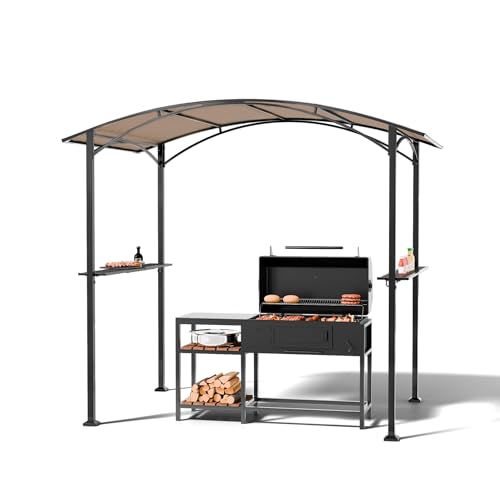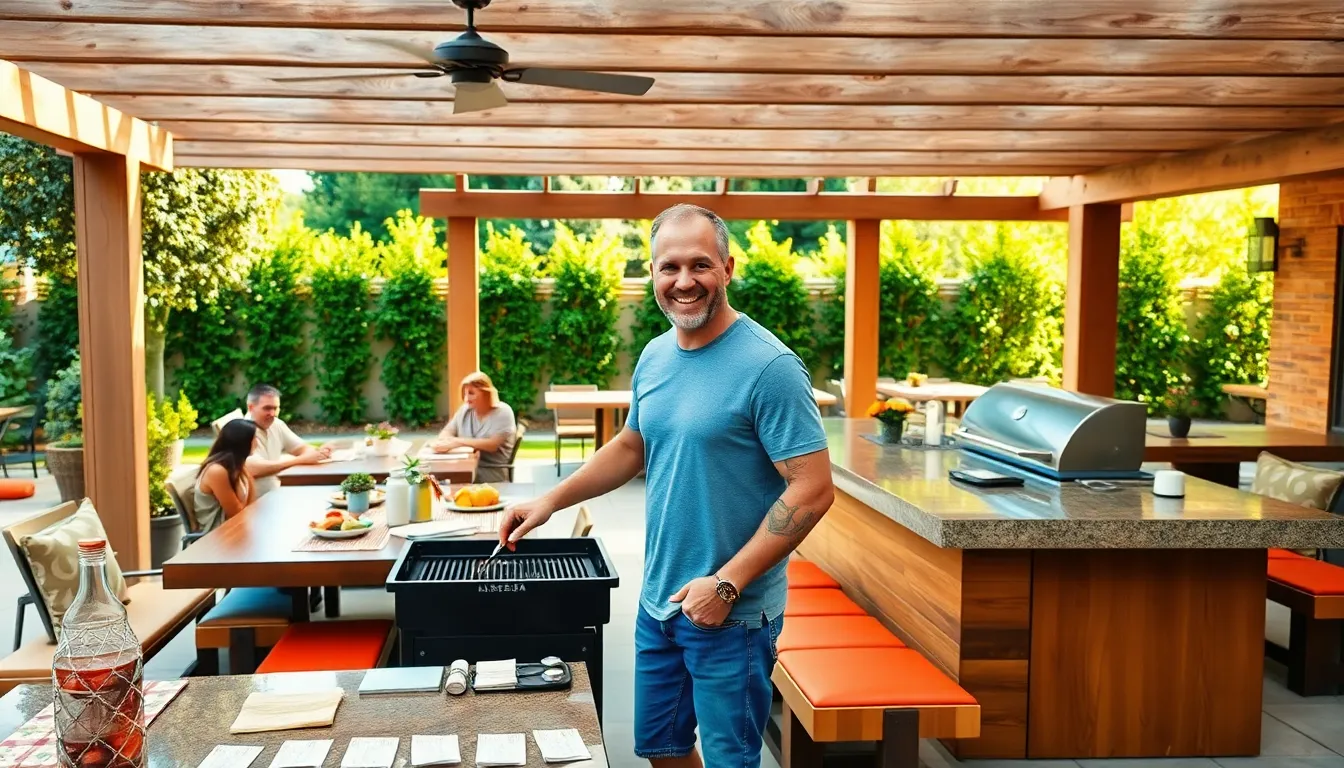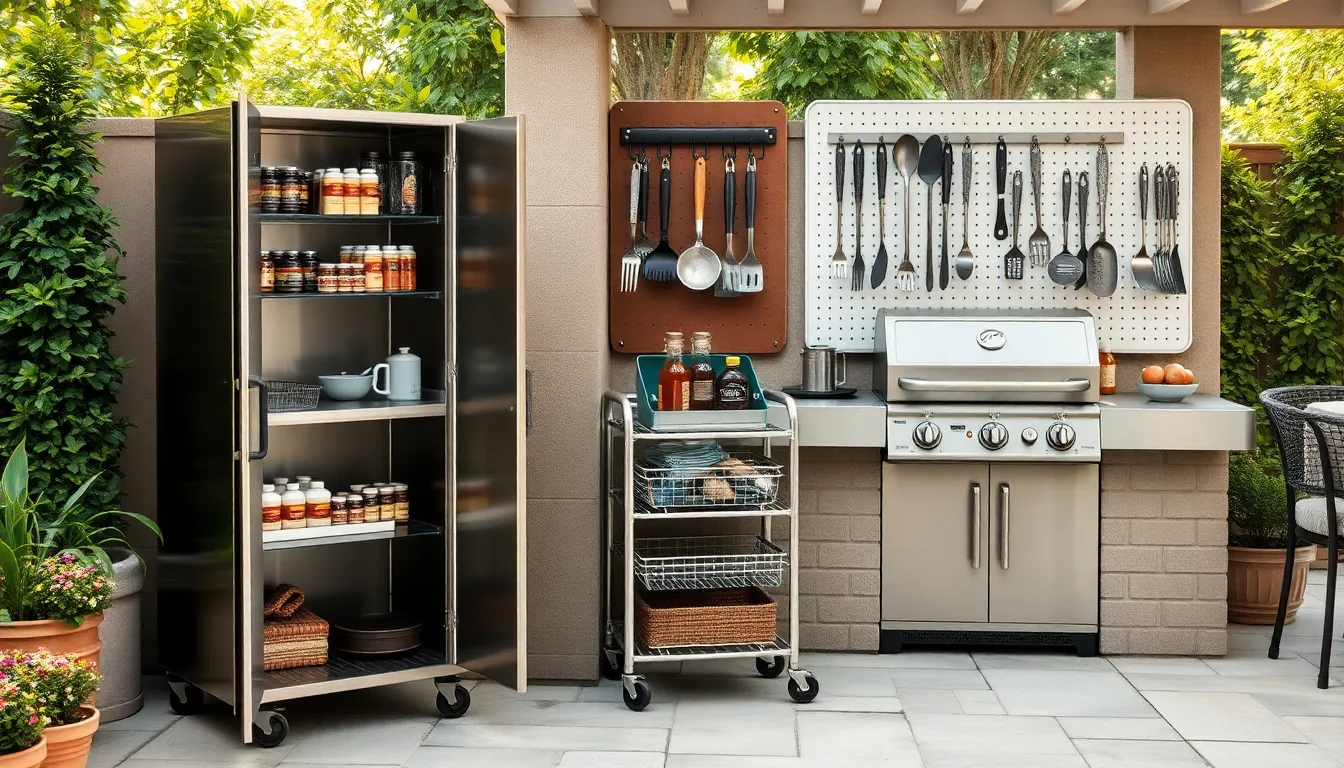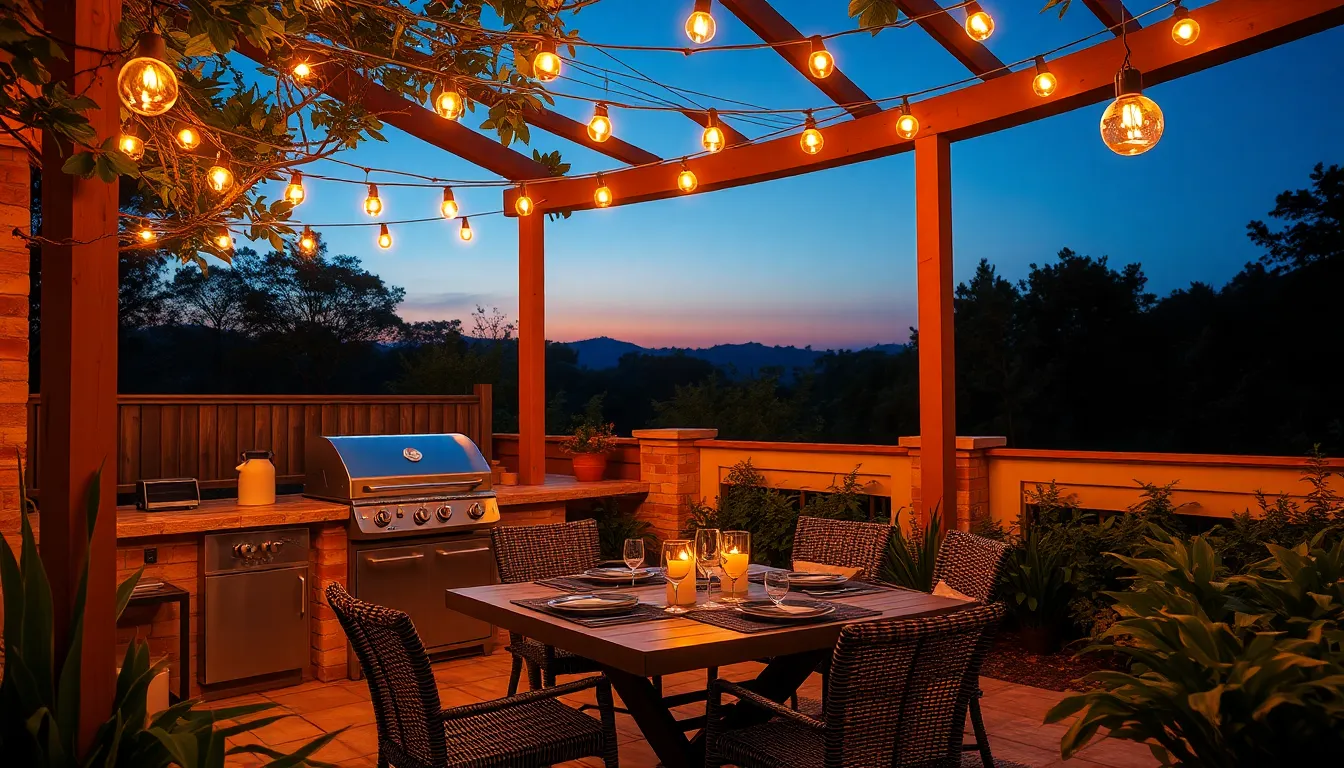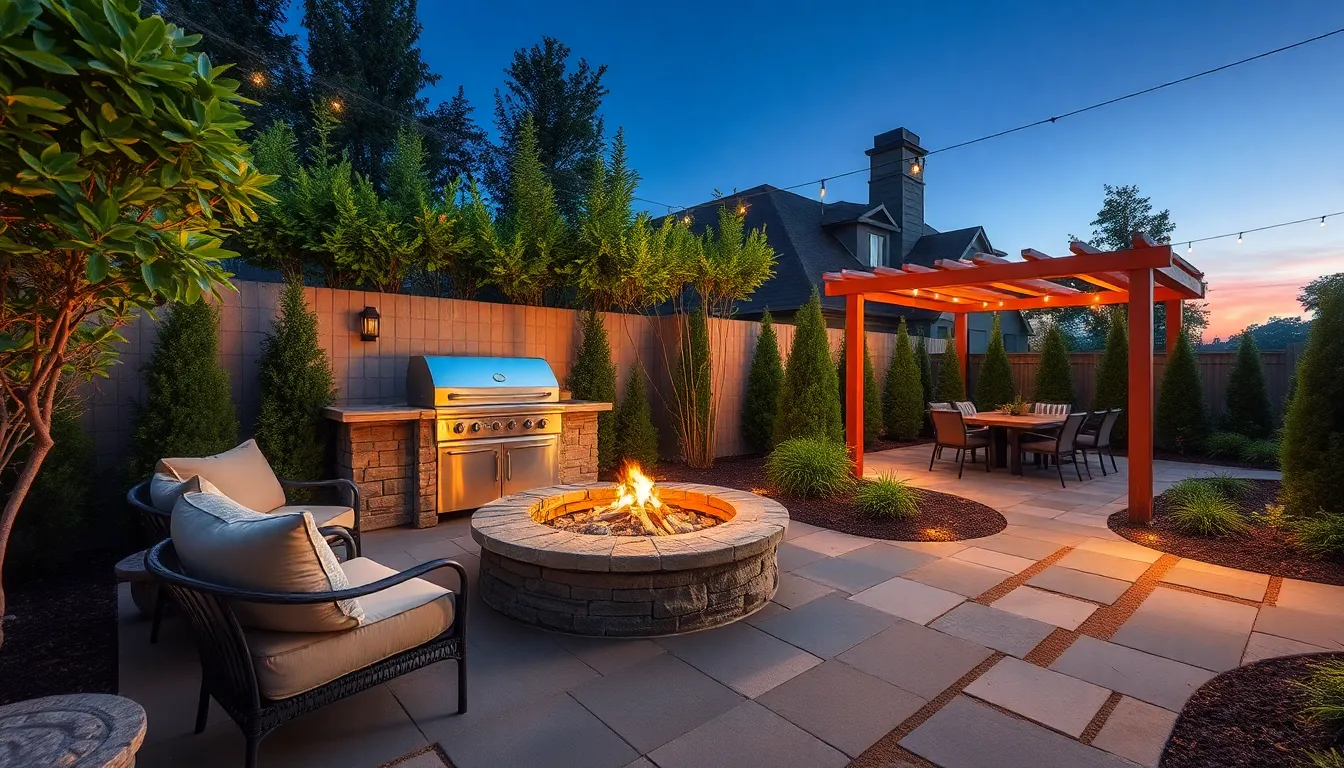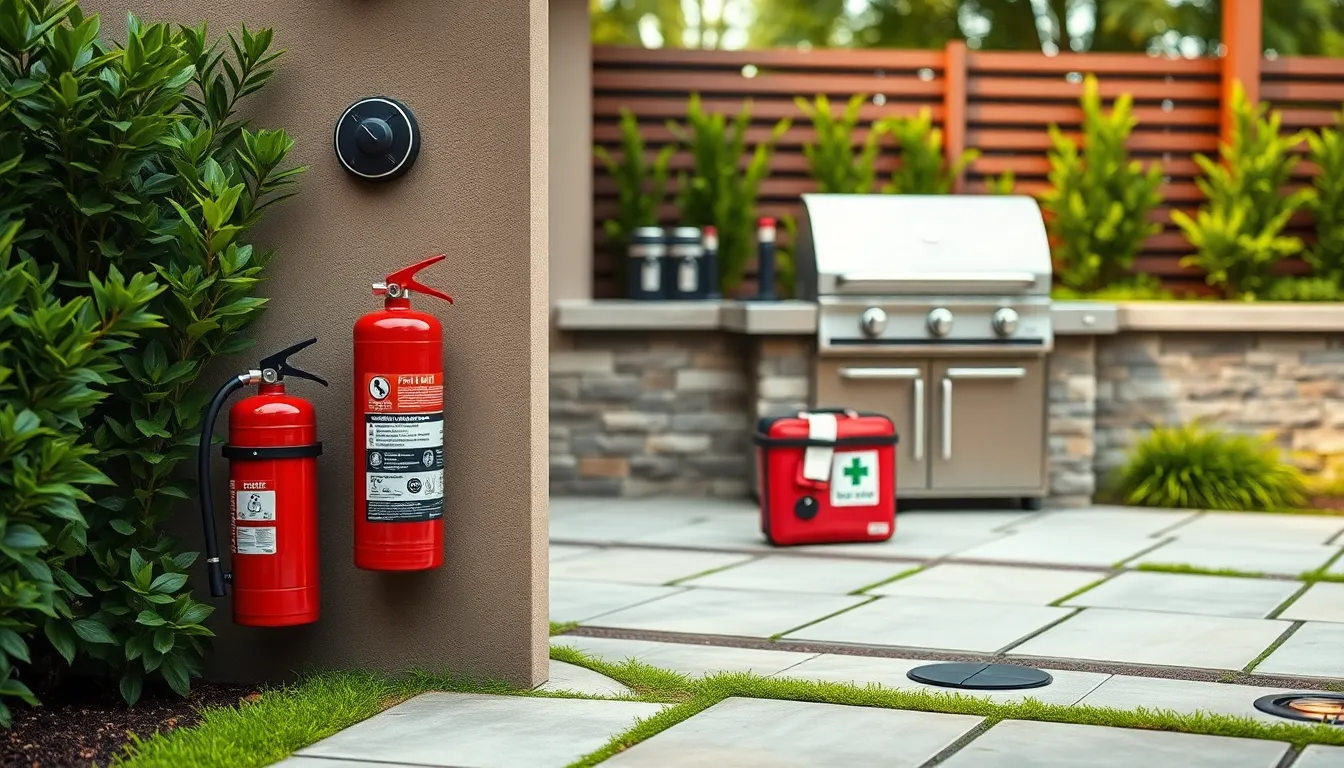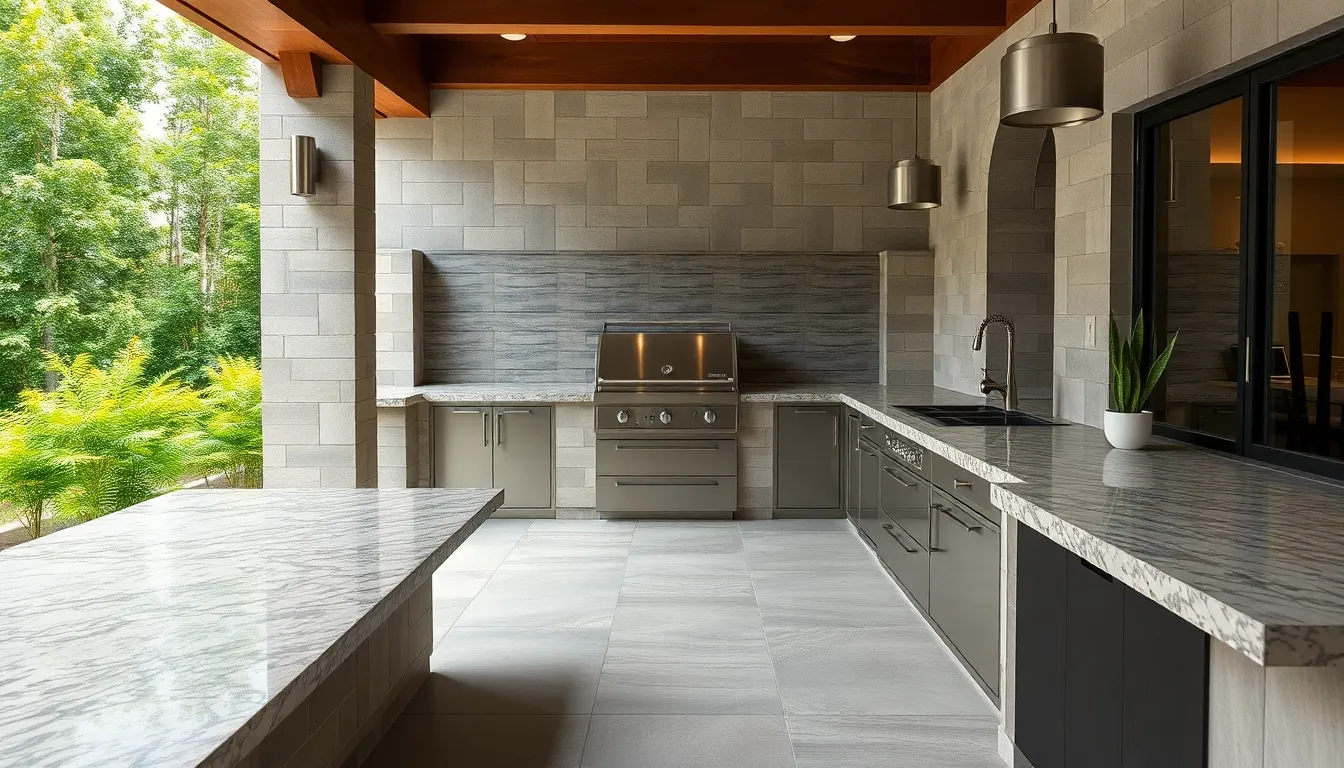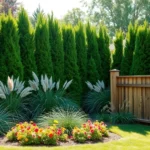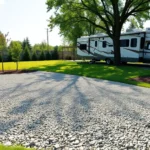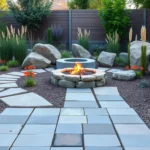Creating the perfect outdoor BBQ area transforms your backyard into the ultimate entertainment destination. Whether you’re hosting weekend gatherings or enjoying quiet family dinners under the stars, a well-designed BBQ space becomes the heart of your outdoor living experience.
We’ve discovered that the best BBQ areas combine functionality with style, creating spaces that are both practical for cooking and inviting for guests. From simple patio setups to elaborate outdoor kitchens, there’s a BBQ solution that fits every budget, space, and lifestyle.
The key to designing an outstanding BBQ area lies in understanding your exact needs and maximizing your available space. We’ll explore creative ideas that’ll help you build a BBQ area that not only enhances your outdoor cooking experience but also adds important value to your property. Get ready to discover inspiring designs that’ll make your neighbors wish they had your backyard setup.
Create a Dedicated Grilling Zone With Proper Spacing
Establishing your grilling zone requires thoughtful consideration of space allocation and safety protocols. We’ll explore the essential elements that transform your backyard into a functional and secure BBQ environment.
Plan Your Layout for Safety and Functionality
Safety zones demand careful measurement and strategic placement of your grilling equipment. Position your grill at least 10 feet away from your house to prevent fire hazards and heat damage to siding materials. Create distinct work areas by allocating 3 feet of space on each side of your grill for food preparation and utensil storage.
Traffic flow patterns need clear pathways to avoid accidents during cooking sessions. Design walkways that are 4 feet wide minimum to accommodate multiple people moving between your house and grilling area. Place your prep station within arm’s reach of the grill while maintaining enough distance for safe maneuvering around hot surfaces.
Storage answers enhance functionality when positioned strategically throughout your grilling zone. Install weatherproof cabinets or storage boxes within 6 feet of your cooking area to keep tools, seasonings, and cleaning supplies easily accessible. Designate separate areas for clean and dirty items to maintain proper food safety standards.
Consider Wind Patterns and Smoke Direction
Wind direction analysis prevents smoke from overwhelming your guests and neighbors. Observe your yard’s prevailing wind patterns during different times of day and seasons before finalizing your grill placement. Position your cooking area so smoke naturally flows away from seating areas and toward open spaces in your yard.
Seasonal wind changes require flexible answers for optimal smoke management. Install adjustable wind screens or privacy panels that can redirect airflow when weather patterns shift throughout the year. Choose materials like tempered glass or metal screens that withstand weather conditions while maintaining clear sightlines.
Natural barriers help control smoke dispersion without blocking your view. Plant strategic landscaping elements like shrubs or small trees on the windward side of your grilling area to create natural windbreaks. Select plants that can tolerate heat and occasional smoke exposure while adding aesthetic value to your outdoor space.
Ensure Adequate Clearance From Structures
Building codes typically require 10 feet minimum clearance from combustible structures. Check your local regulations before installation since some areas mandate greater distances based on grill type and fuel source. Document these measurements to ensure compliance during home inspections or insurance evaluations.
Overhead clearances protect both your property and cooking equipment from damage. Maintain at least 8 feet of vertical space above your grill to prevent heat damage to overhangs, tree branches, or utility lines. Remove any low hanging branches or relocate equipment that might interfere with safe operation.
Property line considerations prevent conflicts with neighbors and legal issues. Position your grilling area at least 5 feet from property boundaries to minimize smoke and noise impact on adjacent homes. Communicate with neighbors about your plans to maintain positive relationships and address any concerns proactively.
Build a Stunning Stone or Brick BBQ Island
Stone and brick BBQ islands create the perfect foundation for your outdoor cooking dreams. These materials offer unmatched durability while delivering that rustic, traditional aesthetic that naturally complements your backyard industry.
Design Custom Built-In Grilling Stations
Custom built-in grilling stations let you tailor your BBQ island to match your exact cooking style and preferences. We recommend designing stations that accommodate gas, charcoal, or pellet grills while maintaining proper safety clearances of at least 3 feet from any flammable objects.
Expanding your cooking options becomes effortless when you incorporate elements like pizza ovens or smokers directly into your station design. These additions transform your BBQ island from a simple grilling setup into a comprehensive outdoor kitchen that handles everything from quick weeknight dinners to elaborate weekend feasts.
Planning your layout requires careful consideration of wind direction and proximity to your house to prevent smoke from drifting indoors or onto your guests. We suggest positioning your grilling station so prevailing winds carry smoke away from seating areas and your home’s windows and doors.
Add Storage Cabinets and Prep Surfaces
Built-in storage cabinets made from steel or other weatherproof materials keep your grilling tools, utensils, spices, and cleaning supplies organized and easily accessible. These cabinets eliminate the need for constant trips back to your kitchen while protecting your equipment from the elements.
Installing prep surfaces adjacent to your grill creates an efficient workflow that makes outdoor cooking more enjoyable and less stressful. We recommend positioning these surfaces within arm’s reach of your grill to minimize movement while handling food and ingredients.
Combining eating countertops with prep areas maximizes your available space, especially beneficial for smaller patios where every square foot counts. This dual-purpose approach lets you prepare food and serve guests from the same surface, creating a more social cooking experience.
Install Utility Connections for Gas and Water
Gas line connections provide the convenience of instant, controllable heat without the hassle of propane tank refills or charcoal preparation. We recommend hiring licensed professionals to install these connections safely and according to local building codes.
Water hookups transform your BBQ island into a truly self-sufficient outdoor kitchen, allowing you to wash hands, rinse vegetables, or clean dishes without leaving your cooking area. These connections prove especially valuable during large gatherings when indoor kitchen access becomes limited.
Planning utility access during your design phase ensures clean integration into your island’s structure rather than unsightly afterthought additions. We suggest mapping out all utility runs before construction begins to avoid costly modifications later in the building process.
Install Weather-Resistant Overhead Coverage
Protecting your outdoor BBQ area from unpredictable weather elements ensures year-round functionality and comfort. Durable overhead coverage transforms your grilling space into a versatile entertainment zone that withstands sun, rain, and debris.
Choose Between Pergolas and Gazebos
Pergolas offer an elegant open-air solution that beautifully defines your BBQ space while maintaining an airy atmosphere. We can enhance these structures with retractable canopies or encourage climbing plants like wisteria or grapevines to create natural shade and weather protection. The versatile design allows for customization based on your exact aesthetic preferences and protection needs.
Gazebos provide more comprehensive shelter with their enclosed design and solid or screened roofing options. We recommend this choice when you need robust protection against wind and rain during cooking sessions. Their structured walls create a defined entertaining space that shields guests from harsh weather conditions while maintaining visual appeal.
Add Retractable Awnings for Flexibility
Retractable awnings deliver the ultimate flexibility for your outdoor BBQ area by adapting to changing weather conditions throughout the day. We can extend them during sunny afternoons for shade protection and retract them for stargazing or open-air grilling experiences. This space-saving solution complements existing structures like pergolas or patios without overwhelming your backyard design.
Modern motorized options allow effortless operation with remote controls or smartphone apps. We find these systems particularly valuable for accommodating spontaneous weather changes while entertaining guests. The ability to quickly adjust coverage ensures your BBQ area remains functional regardless of conditions.
Consider Solid Roof Options for Year-Round Use
Solid roof installations provide maximum protection for serious outdoor cooking enthusiasts who want to use their BBQ area throughout all seasons. We recommend permanent patio roofs or gazebos with solid tops made from durable materials like metal or tile for long-term weather resistance. These structures completely shield your cooking and dining areas from rain, snow, and intense sunlight.
Year-round usability becomes possible when we combine solid roofing with outdoor heaters for winter cooking or ceiling fans for summer comfort. The investment in permanent overhead coverage pays dividends by extending your outdoor entertaining season and protecting expensive grilling equipment from weather damage.
Design Comfortable Seating and Dining Areas
Creating a dedicated dining area near your grill space transforms your outdoor BBQ zone into a complete entertainment hub. We recommend using weather-resistant materials such as stone, steel, or durable tiles to ensure longevity and easy maintenance in outdoor conditions.
Create Bar-Style Seating Around the Grill
Bar-style seating directly around your grill or cooking island promotes interaction between the cook and guests, making the BBQ a more captivating and social experience. We suggest incorporating raised counters with bar stools to create this ever-changing workspace where conversation flows naturally while food preparation happens.
Using durable materials such as concrete or metal ensures longevity and ease of maintenance in outdoor conditions. This setup allows guests to watch the cooking process up close while enjoying drinks and appetizers before the main meal.
Position bar stools at optimal heights that match your grill’s counter level, typically 42 inches high for standard outdoor kitchen islands. Consider weather-resistant cushions for added comfort during longer gatherings.
Add Picnic Tables for Family Gatherings
Traditional picnic tables offer a casual and practical seating option for larger family gatherings where multiple generations come together. They provide ample space for multiple guests and foster a communal eating atmosphere that encourages sharing and conversation.
Position picnic tables under a covered area or pergola to protect from sun and rain, increasing comfort during meals throughout different seasons. We recommend choosing tables made from treated cedar or composite materials that withstand weather exposure without frequent maintenance.
Space picnic tables at least 6 feet apart to allow comfortable movement between seating areas during busy family events. Consider adding umbrellas or shade sails above uncovered tables for additional sun protection during daytime barbecues.
Install Built-In Bench Seating With Storage
Built-in bench seating maximizes space efficiency while adding convenience by incorporating storage underneath for BBQ utensils, cushions, or outdoor accessories. This solution creates cozy, space-efficient seating zones around the BBQ area without requiring additional furniture purchases.
Using materials like sealed wood, stone, or concrete ensures the benches withstand weather exposure while maintaining their structural integrity over time. We suggest adding hinged tops or removable panels for easy access to stored items.
Design bench heights between 18-20 inches for optimal comfort, with depths of at least 15 inches to accommodate adult seating. Consider adding cushions or seat pads that can be easily removed and stored during inclement weather.
Install drainage holes in storage compartments to prevent water accumulation that could damage stored items or create unwanted moisture issues.
Incorporate Convenient Storage Solutions
Effective storage transforms your outdoor BBQ area from chaotic to organized, ensuring everything you need stays within arm’s reach while protected from the elements.
Build Weather-Proof Storage Cabinets
Weather-proof storage cabinets serve as the backbone of an organized grilling space, protecting your valuable BBQ equipment from rain, heat, and humidity. Stainless steel options resist rust and maintain their appearance through countless seasons, while marine-grade polymer cabinets offer lightweight durability at a lower cost. Teak wood provides natural weather resistance with an elegant aesthetic that complements outdoor decor.
Multi-compartment designs maximize organization by creating dedicated spaces for different items like propane tanks, grill covers, and cooking utensils. Secure storage keeps expensive equipment safe from theft while preventing moisture damage that can ruin metal tools and electronics. We recommend installing cabinets with adjustable shelving to accommodate items of varying sizes, from small spice containers to bulky charcoal bags.
Strategic placement near your grill ensures quick access during cooking, eliminating the need to run back and forth to indoor storage. Locking mechanisms add security for valuable items like premium grilling accessories and power tools used for outdoor maintenance.
Add Rolling Carts for Portable Equipment
Rolling BBQ carts enhance mobility and versatility by bringing all your grilling essentials directly to where you need them most. Multiple shelves organize condiments, side dishes, and cooking tools in one convenient unit that moves effortlessly around your outdoor space. Weather-resistant construction ensures these carts withstand outdoor conditions without deteriorating.
Adaptable positioning allows you to adjust your setup based on guest seating arrangements or different cooking locations throughout your yard. Heavy-duty wheels navigate various surfaces from smooth patios to slightly uneven grass areas, making these carts practical for any outdoor terrain.
Efficient workflow improves when everything stays within reach, reducing the time spent searching for tools and ingredients. We suggest choosing carts with built-in drawers for smaller items and open shelving for frequently used supplies like plates and serving utensils.
Design Overhead Storage for Grilling Tools
Overhead storage answers maximize vertical space while keeping essential grilling tools visible and accessible above your cooking area. Pegboard systems accommodate spatulas, tongs, brushes, and thermometers on customizable hooks that adjust to your exact tool collection. Weather-resistant finishes protect both the storage system and your tools from outdoor elements.
Fold-down wall cabinets provide enclosed storage that opens when needed and closes to protect contents from weather and dust. These space-saving designs work particularly well in covered outdoor kitchens where wall space allows for permanent installations.
Visual organization keeps tools sorted and prevents the frustration of searching through drawers during active cooking sessions. Hanging systems also free up valuable counter space and cabinet storage for bulkier items that can’t be suspended, creating a more efficient overall layout for your BBQ area.
Add Ambient Lighting for Evening Entertainment
Creating the perfect ambiance for nighttime BBQ gatherings requires strategic lighting that transforms your outdoor space into a magical entertainment hub. Proper lighting extends your grilling season and ensures safe cooking after dark while adding visual appeal to your BBQ area.
Install String Lights for Festive Atmosphere
String lights overhead create a festive and warm ambiance that’s perfect for social gatherings around your BBQ area. These versatile lighting answers add charm and sparkle without overpowering the natural surroundings, making them ideal for entertaining guests during evening hours.
We recommend installing string lights in a criss-cross pattern above your dining area to establish distinct zones within your outdoor space. Edison bulb string lights provide a vintage aesthetic that complements stone and brick BBQ islands beautifully. Cafe-style string lights work exceptionally well when draped between pergola posts or attached to overhead structures.
Battery-powered string lights offer installation flexibility without requiring electrical connections. Commercial-grade outdoor string lights withstand weather conditions better than standard indoor versions, ensuring long-lasting performance throughout multiple grilling seasons.
Use Solar-Powered LED Fixtures
Solar-powered LED fixtures provide an eco-friendly and low-maintenance lighting solution for your BBQ area. These energy-efficient options can be strategically placed around the BBQ area and dining spaces to softly illuminate paths and seating zones without increasing your electricity costs.
We suggest positioning solar LED fixtures along walkways to maintain the 4-foot clearance we discussed earlier while providing safe navigation. Decorative solar lanterns on tables create intimate lighting that enhances the dining experience without interfering with grilling activities.
Modern solar LED fixtures charge during daylight hours and automatically activate at dusk, providing 6-8 hours of continuous illumination. Weather-resistant solar fixtures withstand outdoor conditions while requiring minimal maintenance compared to hardwired alternatives.
Add Task Lighting for Safe Nighttime Grilling
Task lighting near the grill and prep stations ensures safety and precision while cooking after dark. Focused illumination prevents accidents and makes grilling easier and more enjoyable by providing clear visibility of food, utensils, and grill controls.
We recommend installing mounted LED spotlights positioned 10-15 feet away from the grill to prevent heat damage while delivering adequate brightness. Under-cabinet lights designed specifically for outdoor use illuminate prep surfaces effectively without creating glare that interferes with cooking.
Proper task lighting helps you clearly see food doneness and grill temperatures, reducing the risk of overcooking or undercooking. Motion-activated LED fixtures provide hands-free operation when your hands are full with grilling tools and platters. Adjustable LED spotlights allow you to direct light exactly where needed during different cooking tasks.
Include Water Features and Landscaping Elements
Transforming your BBQ area into a complete outdoor oasis requires thoughtful integration of natural elements that enhance both aesthetics and functionality. We’ll explore how strategic landscaping additions can elevate your grilling space while creating a more comfortable environment for guests.
Create Natural Windbreaks With Plants
Planting dense shrubs, tall grasses, or small trees around your BBQ area serves as an effective natural windbreak. Strategic placement of these plants helps protect cooking flames from strong gusts and increases comfort for guests by reducing wind chill during breezy conditions.
We recommend positioning wind-resistant plants like bamboo, ornamental grasses such as fountain grass, or evergreen shrubs approximately 6-8 feet from your grill. Arborvitae hedges create excellent barriers while maintaining visual appeal throughout the seasons. Japanese yew and boxwood shrubs offer year-round protection and require minimal maintenance once established.
These natural barriers work more effectively than artificial windscreens because they filter wind rather than creating turbulence. Plants absorb wind energy gradually, creating a calmer microclimate around your cooking area while adding natural beauty to the space.
Add Fire Pits for Extended Outdoor Time
Installing a fire pit near your BBQ zone extends outdoor usability well into cooler evenings and colder months. We suggest positioning fire pits 10-15 feet away from the main grilling area to create distinct zones while maintaining safety clearances.
Stone-lined fire pits complement brick or stone BBQ islands perfectly, creating a cohesive design throughout your outdoor space. Portable fire bowls offer flexibility for rearranging seating configurations based on guest count and weather conditions. Built-in fire pits with surrounding stone seating provide permanent gathering spots where guests can relax and socialize after meals.
These dual-purpose features create cozy atmospheres for post-dinner conversations while providing warmth during shoulder seasons. Fire pits also serve as natural focal points that draw people together, extending your entertaining capabilities beyond traditional grilling hours.
Design Pathways and Decorative Borders
Creating defined pathways using stone or paver materials guides foot traffic safely around your BBQ setup while adding visual structure to the space. We recommend installing walkways that are at least 3-4 feet wide to accommodate multiple guests moving between cooking and dining areas.
Decorative borders using bricks, natural stones, or low hedges help delineate different functional zones within your outdoor kitchen. These borders create clear boundaries between cooking areas, prep spaces, and seating zones while preventing accidental contact with hot surfaces.
Natural stone pathways blend seamlessly with existing landscaping while providing durable surfaces that withstand heavy foot traffic. Brick borders around planted areas add traditional charm and prevent soil erosion near high-traffic zones. Low-maintenance ground covers like creeping thyme or moss can fill gaps between pavers, creating living pathways that release pleasant fragrances when stepped on.
We suggest incorporating industry lighting along pathways to ensure safe navigation during evening gatherings. Solar-powered path lights eliminate the need for electrical connections while providing consistent illumination throughout the night.
Plan Essential Utility and Safety Features
Creating a safe and functional outdoor BBQ area requires careful attention to utility systems and safety measures that protect both people and property. We’ll explore the critical infrastructure elements that transform your outdoor cooking space into a secure environment for memorable gatherings.
Install Proper Drainage Systems
Drainage systems prevent water accumulation near cooking areas, which creates slippery conditions and damages appliances or structures. We recommend installing proper drainage to keep your BBQ area dry and safe while facilitating easy cleaning and maintenance.
Strategic placement of drainage channels around your cooking zone eliminates standing water that can cause accidents. Graded surfaces direct water away from high-traffic areas where family and guests gather. Permeable materials like gravel or porous pavers allow water to filter through naturally rather than pooling on surfaces.
French drains work exceptionally well for outdoor kitchens, channeling water away from cooking appliances and seating areas. We suggest positioning drain systems at least 6 inches from any cooking equipment to prevent moisture damage. Proper drainage also extends the life of your outdoor furniture and prevents rust on metal components.
Add Fire Extinguisher and First Aid Stations
Fire extinguishers and first aid kits should be readily accessible near your cooking area for quick emergency response. We position these safety essentials within 10 feet of the grill to ensure immediate availability during emergencies.
Mount weather-resistant fire extinguisher cabinets at eye level for easy visibility and access. ABC-rated fire extinguishers handle grease, wood, and electrical fires commonly associated with outdoor cooking. We recommend checking expiration dates monthly and replacing units as needed.
First aid stations require waterproof containers that protect supplies from moisture and insects. Stock kits with burn gel, bandages, antiseptic wipes, and emergency contact information. Position first aid supplies away from heat sources but within quick reach of the cooking area.
Consider installing emergency lighting near safety stations to ensure visibility during nighttime cooking sessions. We suggest solar-powered options that don’t require electrical connections and provide reliable illumination when needed most.
Consider Electrical Outlets and GFCI Protection
Electrical outlets should be strategically placed for powering appliances, lighting, and entertainment devices throughout your outdoor BBQ area. We install outlets at convenient locations while maintaining safe distances from water sources and heat-generating equipment.
All outdoor outlets must have Ground Fault Circuit Interrupter (GFCI) protection to prevent electrical shock hazards in the presence of moisture. GFCI outlets automatically shut off power when they detect electrical imbalances, protecting users from dangerous shocks.
We recommend installing outlets at least 6 feet from water features and 3 feet from cooking surfaces to prevent accidental contact with moisture or heat. Weatherproof outlet covers protect connections from rain and debris when not in use.
Consider dedicated circuits for high-power appliances like outdoor refrigerators or electric grills. We suggest consulting with licensed electricians to ensure proper amperage and code compliance for your exact needs. USB charging stations integrated into weatherproof housings provide convenient device charging for outdoor entertainment.
Choose Durable Materials for Long-Lasting Appeal
Building your outdoor BBQ area with the right materials sets the foundation for years of enjoyable grilling and entertaining. We’ll focus on materials that withstand weather extremes while maintaining their appeal and functionality.
Select Weather-Resistant Flooring Options
Natural stone flooring provides exceptional durability against outdoor elements while offering timeless beauty that complements any BBQ area design. Stone surfaces like granite, limestone, and slate resist moisture penetration and temperature fluctuations that typically damage inferior materials. Concrete flooring delivers outstanding weather resistance at a budget-friendly price point, making it an excellent choice for larger BBQ areas where cost efficiency matters.
Premium outdoor tiles offer another weather-resistant solution that combines style flexibility with practical performance. These specialized tiles resist freeze-thaw cycles, heavy foot traffic, and grease spills that occur during active grilling sessions. We recommend choosing flooring materials that maintain their slip resistance even when wet, ensuring safety around water features and during unexpected weather changes.
Pick Low-Maintenance Surface Materials
Polished concrete surfaces create a sleek, modern appearance while requiring minimal upkeep throughout the seasons. This versatile material resists stains, scratches, and weather damage without needing regular sealing or refinishing like traditional wood surfaces. Stone surfaces like granite countertops and limestone accent walls deliver long-lasting beauty with simple cleaning routines using basic soap and water.
Stucco finishes provide budget-conscious options that resist heat and create seamless transitions between indoor and outdoor spaces. But, we advise considering your climate carefully since stucco may crack under freezing conditions or excessive moisture exposure. Precast concrete panels eliminate layered finishes that crumble over time while integrating color and texture directly into the material itself.
Invest in Quality Hardware and Fixtures
Stainless steel hardware ensures your BBQ area maintains its functionality and appearance even though constant weather exposure. Cabinet handles, hinges, and appliance fixtures made from marine-grade stainless steel resist corrosion and daily wear from grilling activities. We recommend investing in quality fixtures upfront rather than replacing inferior hardware repeatedly over time.
Weatherproof cabinet systems using stainless steel construction provide reliable storage that protects grilling tools and supplies from moisture damage. These professional-grade materials complement concrete panels and brick structures while maintaining consistent performance standards. Door latches, drawer slides, and mounting brackets should all meet outdoor durability standards to ensure smooth operation season after season.
Conclusion
We’ve covered everything you need to transform your backyard into the ultimate BBQ destination. From strategic grill placement and safety protocols to stunning stone islands and comfortable seating areas your outdoor cooking space can become the heart of your home’s entertainment zone.
Remember that successful BBQ areas blend functionality with style while prioritizing safety and durability. Whether you’re working with a compact patio or expansive yard these ideas can be adapted to fit your space and budget.
The key lies in thoughtful planning that considers wind patterns utilities and traffic flow. With weather-resistant materials proper lighting and convenient storage answers you’ll create an outdoor oasis that extends your living space and increases your property value for years to come.
Frequently Asked Questions
What are the key safety considerations when designing an outdoor BBQ area?
Safety is paramount when designing your BBQ area. Position your grill at least 10 feet away from your house and any structures. Ensure clear traffic flow around the cooking zone to prevent accidents. Install fire extinguishers and first aid stations within 10 feet of the grill for quick emergency access. Consider wind patterns to manage smoke direction effectively.
How much space do I need for a functional outdoor BBQ area?
The space requirements depend on your needs and guest capacity. At minimum, allow 10 feet clearance from structures and ensure adequate room for traffic flow around the grill. Consider additional space for seating, storage, and prep areas. Even small patios can accommodate functional BBQ setups with proper planning and space-maximizing solutions.
What materials work best for outdoor BBQ areas?
Choose weather-resistant materials for durability and longevity. Natural stone, concrete, and premium outdoor tiles work well for flooring. Stainless steel is ideal for grills and hardware due to its corrosion resistance. For structures, consider brick or stone for BBQ islands, and weather-resistant wood or metal for pergolas and storage solutions.
Should I include overhead coverage in my BBQ area design?
Yes, overhead coverage is highly recommended for year-round usability. Pergolas, gazebos, or covered pavilions protect you and your guests from sun, rain, and wind. This extends your outdoor cooking season and makes the space more comfortable. Choose materials that complement your home’s architecture and provide adequate ventilation for smoke.
What utilities should I plan for in my outdoor BBQ area?
Essential utilities include gas lines for built-in grills, electrical outlets with GFCI protection for safety, and water access for cleaning and prep. Ensure proper drainage to prevent water accumulation. Consider installing outdoor lighting circuits for evening entertaining and connectivity for outdoor speakers or entertainment systems.
How can I maximize storage in my outdoor BBQ area?
Incorporate weather-proof cabinets into your BBQ island design for storing grilling tools and supplies. Use rolling carts for flexible storage and prep space. Install overhead storage for frequently used items and consider built-in storage benches that serve dual purposes. Organize zones for different activities to maximize efficiency.
What type of seating works best for outdoor BBQ areas?
Choose weather-resistant seating materials like aluminum, teak, or all-weather wicker. Create various seating zones including dining areas, casual lounging spots, and bar-height seating around the grill. Consider built-in benches with storage underneath for space efficiency. Ensure comfortable spacing for easy conversation and movement.
How do I manage smoke and wind in my BBQ area?
Position your grill considering prevailing wind patterns to direct smoke away from seating areas. Install wind screens or use natural barriers like dense shrubs to manage airflow. Consider the placement of your BBQ area in relation to neighbors’ properties. Strategic landscaping can create effective windbreaks while enhancing aesthetics.
What lighting options work best for outdoor BBQ areas?
Combine ambient lighting with task lighting for optimal functionality. String lights create atmosphere, while focused LED lights illuminate cooking and prep areas. Install pathway lighting for safety and consider uplighting for landscaping features. Use dimmable options to adjust lighting levels for different occasions and ensure all fixtures are weather-rated.
How can landscaping enhance my outdoor BBQ area?
Strategic landscaping creates privacy, manages wind, and enhances aesthetics. Use dense shrubs as natural windbreaks and privacy screens. Incorporate water features for ambiance and cooling effects. Plant herbs nearby for fresh cooking ingredients. Choose low-maintenance, drought-resistant plants that complement your outdoor cooking space and require minimal upkeep.

